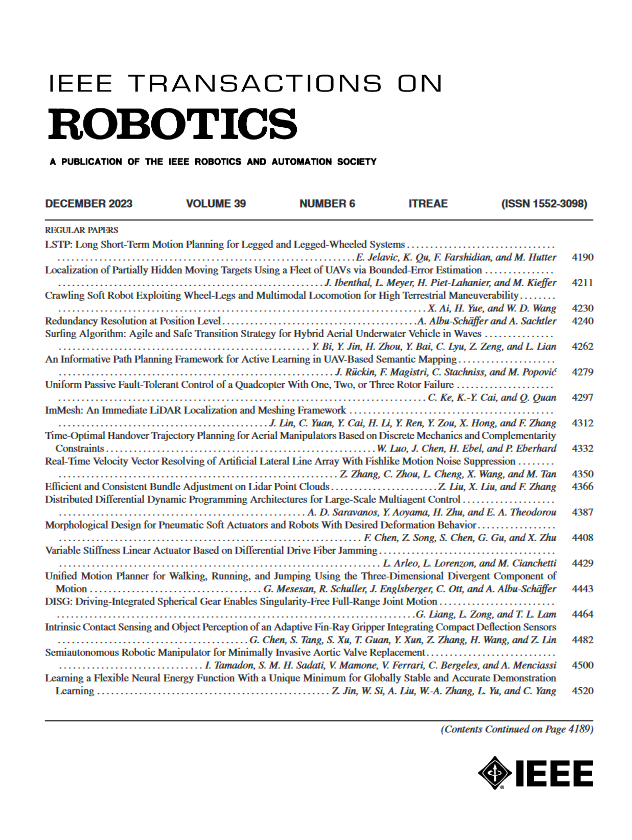机器人中的连续时间状态估计方法综述
IF 10.5
1区 计算机科学
Q1 ROBOTICS
引用次数: 0
摘要
随着机器人平台的多样性和任务的复杂性不断增加,准确、高效和鲁棒的状态估计比以往任何时候都更加重要。从历史上看,离散时间滤波器和平滑器一直是主要的方法,其中估计的变量是离散样本时间的状态。连续时间状态估计范式提出了一种替代策略,通过估计将状态表示为时间的连续函数的变量,可以在任何查询时间对其进行评估。这不仅有利于下游任务,如计划和控制,而且还显著提高了估计器的性能和灵活性,并降低了传感器预处理和接口的复杂性。尽管如此,连续时间方法仍未得到充分利用,可能是因为它们在机器人技术中不太为人所知。为了弥补这一点,这项工作提出了这些方法的统一公式和迄今为止最详尽的文献综述,系统地按方法、应用、状态变量、历史背景和对该领域的理论贡献对先前的工作进行了分类。通过将样条曲线和高斯过程结合起来,结合其他研究领域的工作,本工作识别和分析了连续时间状态估计中存在的开放性问题,并提出了新的研究方向。本文章由计算机程序翻译,如有差异,请以英文原文为准。
Continuous-Time State Estimation Methods in Robotics: A Survey
Accurate, efficient, and robust state estimation is more important than ever in robotics as the variety of platforms and complexity of tasks continue to grow. Historically, discrete-time filters and smoothers have been the dominant approach, in which the estimated variables are states at discrete sample times. The paradigm of continuous-time state estimation proposes an alternative strategy by estimating variables that express the state as a continuous function of time, which can be evaluated at any query time. Not only can this benefit downstream tasks such as planning and control, but it also significantly increases estimator performance and flexibility, as well as reduces sensor preprocessing and interfacing complexity. Despite this, continuous-time methods remain underutilized, potentially because they are less well-known within robotics. To remedy this, this work presents a unifying formulation of these methods and the most exhaustive literature review to date, systematically categorizing prior work by methodology, application, state variables, historical context, and theoretical contribution to the field. By surveying splines and Gaussian process together and contextualizing works from other research domains, this work identifies and analyzes open problems in continuous-time state estimation and suggests new research directions.
求助全文
通过发布文献求助,成功后即可免费获取论文全文。
去求助
来源期刊

IEEE Transactions on Robotics
工程技术-机器人学
CiteScore
14.90
自引率
5.10%
发文量
259
审稿时长
6.0 months
期刊介绍:
The IEEE Transactions on Robotics (T-RO) is dedicated to publishing fundamental papers covering all facets of robotics, drawing on interdisciplinary approaches from computer science, control systems, electrical engineering, mathematics, mechanical engineering, and beyond. From industrial applications to service and personal assistants, surgical operations to space, underwater, and remote exploration, robots and intelligent machines play pivotal roles across various domains, including entertainment, safety, search and rescue, military applications, agriculture, and intelligent vehicles.
Special emphasis is placed on intelligent machines and systems designed for unstructured environments, where a significant portion of the environment remains unknown and beyond direct sensing or control.
 求助内容:
求助内容: 应助结果提醒方式:
应助结果提醒方式:


